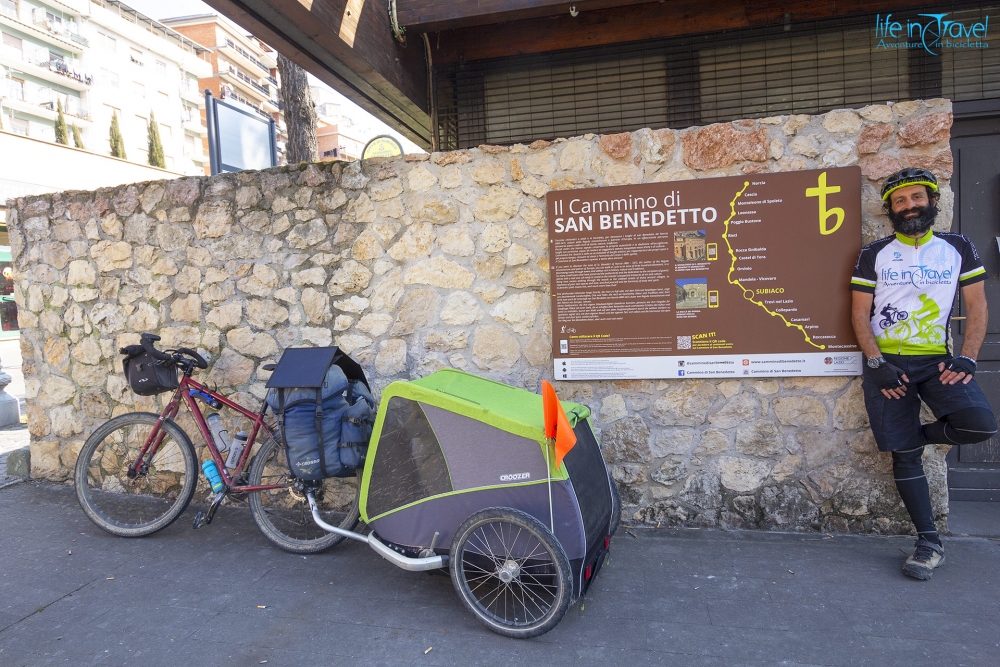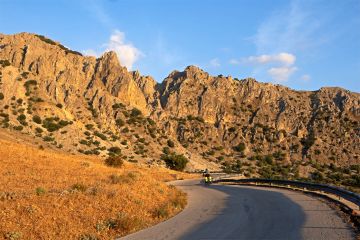The Way of Saint Benedict by bicycle: 300 km from Norcia to Montecassino
It is growing in popularity amongst pilgrims but lately also bicycle travellers, it connects Norcia, in Umbria, to Montecassino, in Lazio. The Way of Sant Benedict by bicycle is a medium-challenging itinerary which, along secondary roads, enjoyable gravel roads and paths, allows to visit the key places of this Saint from Norcia.
Technical Data
The Way of Saint Benedict from Subiaco to Montecassino
| Start/Finish | Subiaco/Montecassino |
| Time | 4-5 days |
| Difference in Height | 3970 m circa |
| Length | 161 km circa |
| Type of road |
90% asphalt
10% gravel
|
| Suggested bicycle |
Mountain Bike
Gravel
Bicycle Touring bicycle
|
| Difficulty |  |
| Views |  |








Files GPS
The Way of Saint Benedict by bicycle
The Way of Saint Benedict by bicycle: from Norcia to Subiaco
In the city of Norcia, where you'll find a giant statue right in the main square of the Saint who was born there, starts this great journey and discovery of some of the most beautiful monasteries of the world. Along 300 km of this cycleway, you'll visit some of the most beautiful villages of Italy, natural beauties, old cities, and majestic castles.
The first leg of the journey crosses the Province of Perugia and from Norcia leads to Cascia until the picturesque Monteleone di Spoleto, the highest point of the entire region with its 978 m. The tree city walls of Monteleone, and maybe the presence of the numerous churches, protected this mountain border outpost for centuries.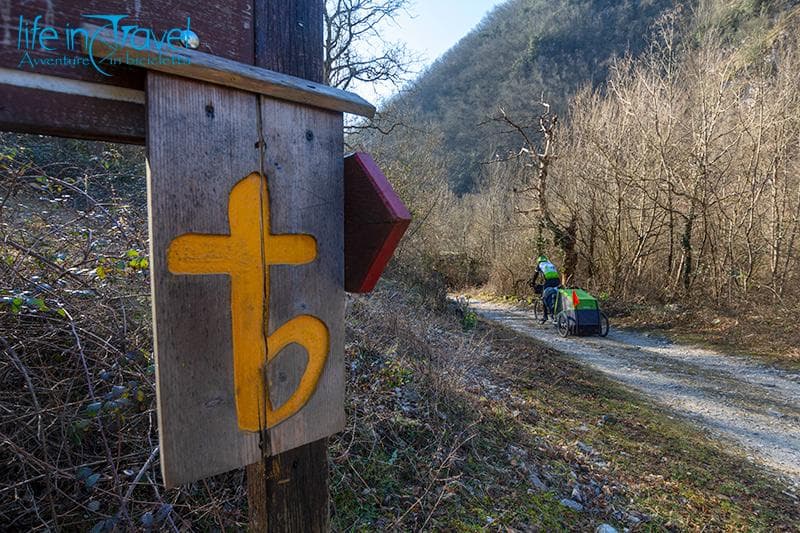
After Umbria, you enter in Leonessa, in the Province of Rieti. Leonessa boasts a convent church from the XIII century dedicated to San Francesco, a famous ski area and the quality mark by Touring Club, the orange flag. From Leonessa the Way of Saint Benedict by bicycle climbs down to Poggio Bustone, known for giving birth to Lucio Battisti, for an excellent production of porchetta and for being the last stop of the Way of Saint Francis, connecting the Shrine of La Verna and Assisi then Poggio Bustone.
The main city of the region Sabina, with two shrines dedicated to San Francesco, is Rieti, that you reach in the next leg of the Way. Rieti is 405m high on Monte Terminillo reaching 2000m. Older than Roma, Rieti has always been considered a living city with its 47000 inhabitants. With its city centre, after following the Ariana stream, you reach the castle Cesarini, the symbol of Rocca Sinibalda, from 1928 national monument. This village is part of the Natural Reserve Navegna and Monte Cervia. In an idyllic landscape of green hills, lakes, and fortresses, following the Way of Saint Benedict bicycle tourists arrive at Castel di Tora, one of the most beautiful villages in Italy. The authenticity of these places convinces the travellers to stay to enjoy the clean air and the amazing glimpses. Castel di Tora seems a fairytale village... Just a little bigger than Castel di Tora and along the Way of Saint Benedict, you can pedal to Orvinio, 370 souls and one of the most beautiful villages of Italy.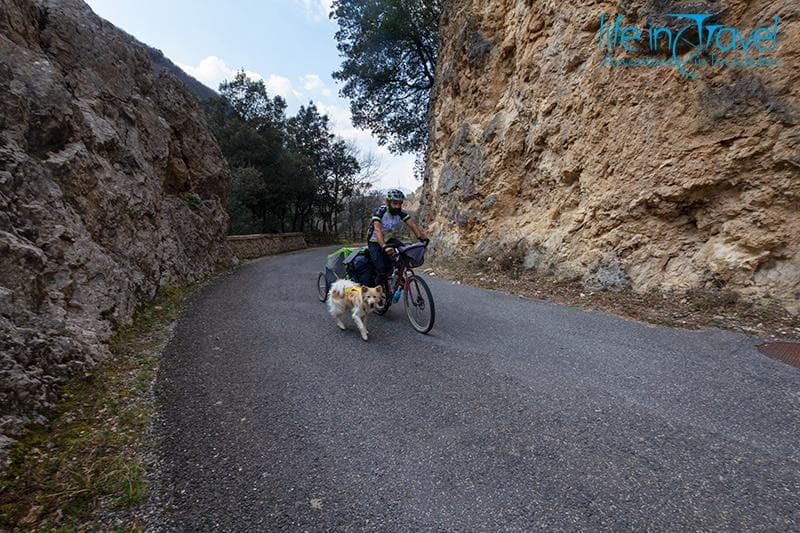 You cannot leave Orvinio, in the Regional Natural Park Monti Lucretili, without visiting castle Malvezzi, what remains of the Abbey of Santa Maria del Piano in Sabina and, obviously the little historic centre 800m above sea level. We are almost halfway into our journey, we have done 140km already.
You cannot leave Orvinio, in the Regional Natural Park Monti Lucretili, without visiting castle Malvezzi, what remains of the Abbey of Santa Maria del Piano in Sabina and, obviously the little historic centre 800m above sea level. We are almost halfway into our journey, we have done 140km already.
From Subiaco to Montecassino by bicycle
From the small centre, the journey along the Way of Saint Benedict y bicycle continues towards Subiaco, where you will find the Benedictine monasteries of Santa Scholastica, the oldest in Italy, and the one of San Benedetto or Sacro Speco.
For sure you will need more than a day to visit Subiaco and its beauties, including Santa Scholastica Monastery, founded by Saint Benedict himself.
The city centre rises up on a hill above the river Aniene, in front of the Simbruini Mountains. 
After the visit, the Way of Saint Benedict by bicycle continues up and down on gravel hills and in the Aniene Valley. This river, in its 99km, shapes the urban and extra-urban landscapes, like Villa d'Este and Villa Gregoriana gardens in Tivoli, it creates some crystal clear natural pools and chilling oasis where you can stop and rest during hot summer days. The river will be your fellow traveler until the Cascata di Trevi (if the bridge over the river will be renovated, don't miss this natural area!).
Just a few meters and you'll be in the Province of Frosinone. Trevi nel Lazio is not far: while going uphill, you'll see the village on top of Monte Viglio, the highest of Càntari Mountains, although it is just an optical illusion. Trevi, dominated by the Castle of Caetani, is a pleasant and attractive place: don't miss its Collegiata with the organ.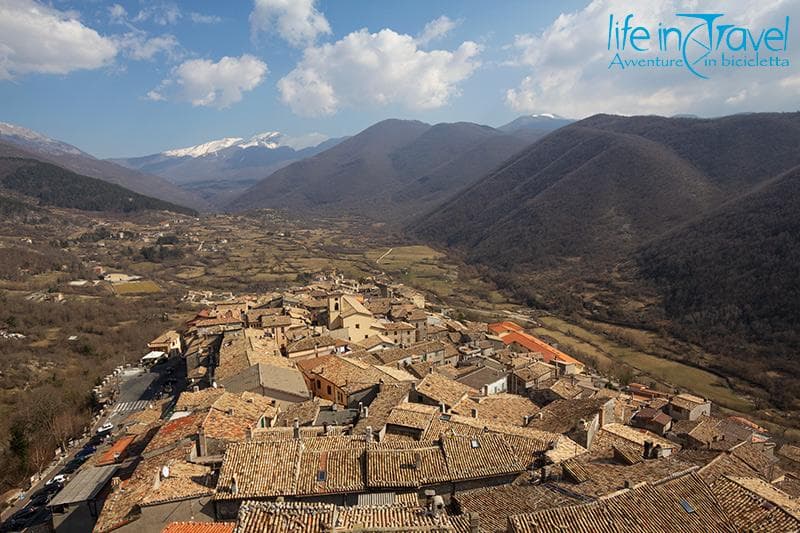
The Way of Saint Benedict runs far from Trevi towards Altipiani d'Arcinazzo, an 850 m high district where, carefully and by a little trekking, during spring and summer you can enjoy the Orchid from the Appennini Mountains. Among grazes of these mountains and woods with wolves, boars and owls you proceed in this quiet along pleasant uphill roads towards Guarcino, historic border between the Papal States and the Kingdom of the Two Sicilies. Just under the centre of Guarcino, you keep gaining meters on the dirt towards Vico nel Lazio, pedalling through terracing of olive trees and breathtaking views. Vico, another village surrounded by walls and up on the hill, counts a few more than 2000 inhabitants and was born among the Ernici Mountains.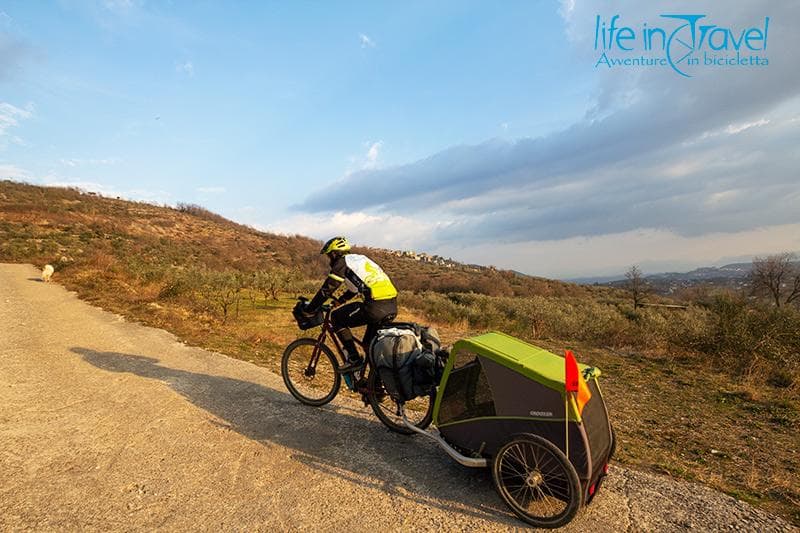 From this village, you can follow the main road to Collepardo or choose the cycle path recently built at the border with the Ernici Mountains. The cycle path offers some equipped areas with tables and boards being an alternative into the green to reach Collepardo, the starting point to climb to Certosa of Trisulti. This charterhouse, now run by Cistercians, benefits from its privileged position. To visit this monument is like tiptoeing on 800 years of history. The journey following Saint Benedict's way by bicycle reaches then Casamari and Isola del Liri with its city waterfall. Montecassino is very close: Arpino with the old Acropolis of Civitavecchia, Roccasecca where Tommaso d'Aquino was born, with the Melfa canyon and Castrocielo with its "Monacato" and the old Aquinum excavation. The last effort is the climb to Montecassino where Benedetto from Norcia built his first monastery and where he died in 547.
From this village, you can follow the main road to Collepardo or choose the cycle path recently built at the border with the Ernici Mountains. The cycle path offers some equipped areas with tables and boards being an alternative into the green to reach Collepardo, the starting point to climb to Certosa of Trisulti. This charterhouse, now run by Cistercians, benefits from its privileged position. To visit this monument is like tiptoeing on 800 years of history. The journey following Saint Benedict's way by bicycle reaches then Casamari and Isola del Liri with its city waterfall. Montecassino is very close: Arpino with the old Acropolis of Civitavecchia, Roccasecca where Tommaso d'Aquino was born, with the Melfa canyon and Castrocielo with its "Monacato" and the old Aquinum excavation. The last effort is the climb to Montecassino where Benedetto from Norcia built his first monastery and where he died in 547.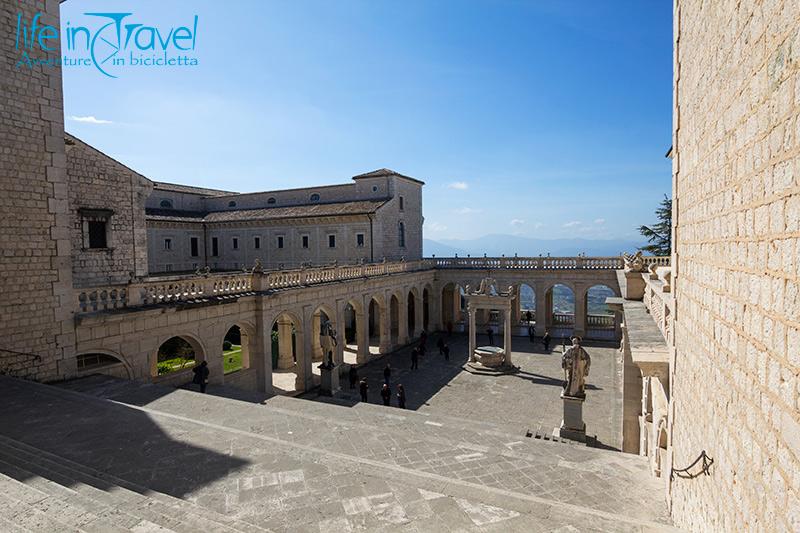
Our journey by bicycle
Subiaco and its monasteries
Subiaco deserves at least one day visit in order to enjoy it together with its Benedictine monasteries. Starting from the lowest part of the city you can climb up to the castle. Park your bike and enjoy the panoramic walk to the big clock tower of the Borgia family.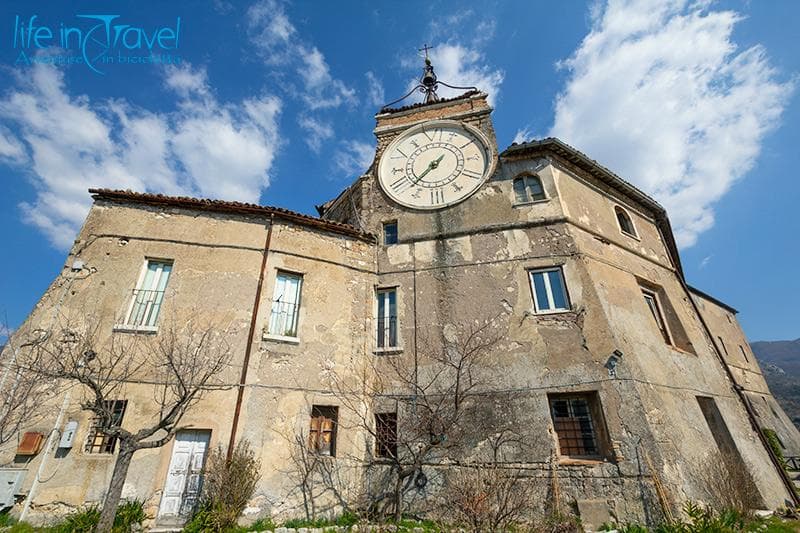 This building, built in the XI century, might be the native place of Cardinal Rodrigo Borgia (who then became Pope Alexander VI) and his lover Vannozza Cattanei's children. Among these four children how not to mention the controversial Lucrezia Borgia! Subiaco's historic centre is worth the visit, at least one hour walk climbing its stairs and steps. Going away from the city, you soon reach the crossing to Saint Scholastica Monastery, the oldest among the Benedictine Monasteries: the building has got three cloisters 8from three different ages) and is dedicated to Saint Benedict's twin sister. You can visit it for free during visiting hours with a guide, and inside you can buy some local produce from the monastery herbalist's shop.
This building, built in the XI century, might be the native place of Cardinal Rodrigo Borgia (who then became Pope Alexander VI) and his lover Vannozza Cattanei's children. Among these four children how not to mention the controversial Lucrezia Borgia! Subiaco's historic centre is worth the visit, at least one hour walk climbing its stairs and steps. Going away from the city, you soon reach the crossing to Saint Scholastica Monastery, the oldest among the Benedictine Monasteries: the building has got three cloisters 8from three different ages) and is dedicated to Saint Benedict's twin sister. You can visit it for free during visiting hours with a guide, and inside you can buy some local produce from the monastery herbalist's shop.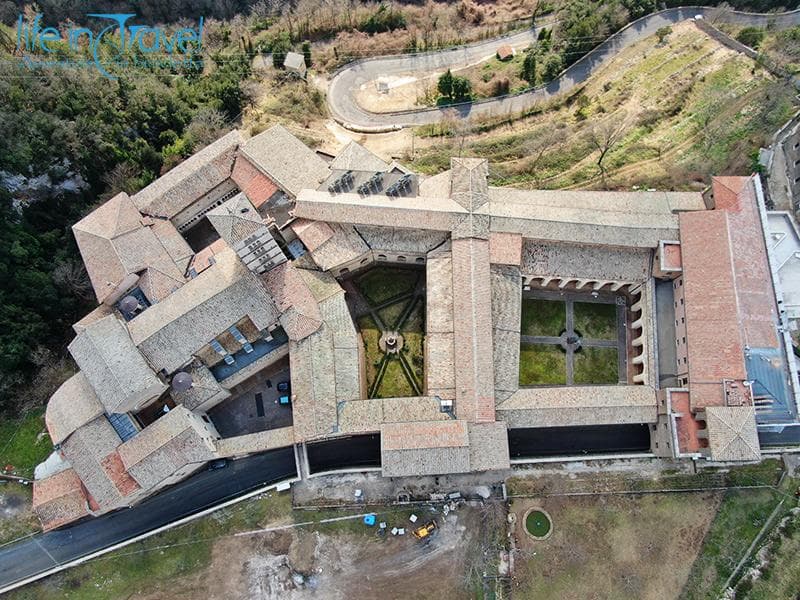
From the monastery, the road climbs up to the Sacro Speco, a magical place where you can breathe deep sacredness. The entrance can be reached by bicycle and you can park your bike in the middle of the lower square just below the steep climb on the stairs towards the entrance.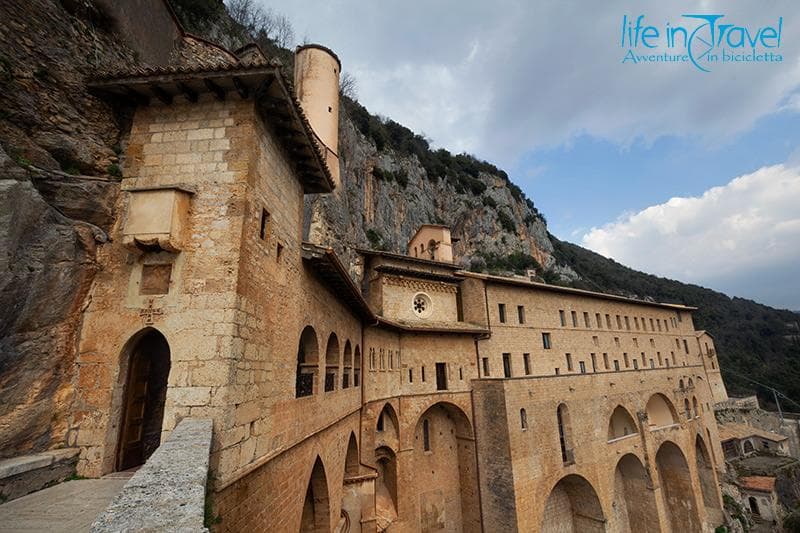 The monastery, encrusted in the rocks and built on different levels, is decorated with colourful frescos from the Siena school and the statue of Saint Benedict from the XVII century.
The monastery, encrusted in the rocks and built on different levels, is decorated with colourful frescos from the Siena school and the statue of Saint Benedict from the XVII century.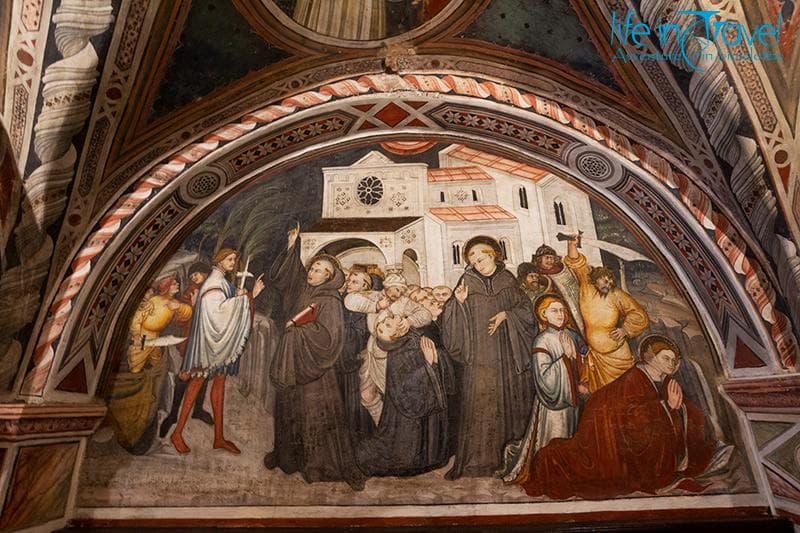 After the visit of these two monasteries (Nala and other dogs are not allowed inside), we come back to the Aniene river, where an inviting gravel road brings us in the heart of this tight valley, up and downhill and with a lot of predatory animals and roe deers. Along the way, there are some beaches, offering the possibility of a swim during summer. We spend our first night of the Way cradled by the sound of Aniene water and by the noisy song of an owl.
After the visit of these two monasteries (Nala and other dogs are not allowed inside), we come back to the Aniene river, where an inviting gravel road brings us in the heart of this tight valley, up and downhill and with a lot of predatory animals and roe deers. Along the way, there are some beaches, offering the possibility of a swim during summer. We spend our first night of the Way cradled by the sound of Aniene water and by the noisy song of an owl.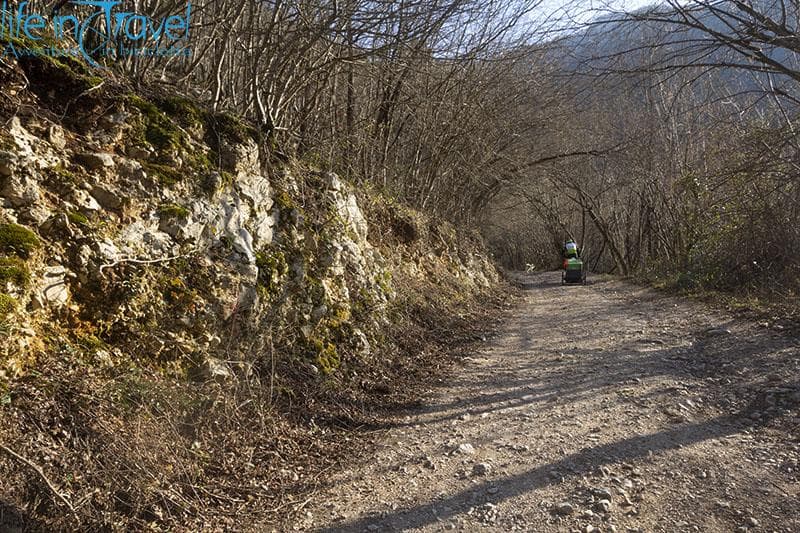
The Aniene valley and the province of Frosinone
The second leg of our Way of Saint Benedict by bicycle doesn't start with the song of a bird but with a motor of a car: we soon discover that being Sunday, this river is well known by fishermen. We spend the usual hour or so disassembling our tent, load our bikes and leave. The road follows the Aniene river uphill and downhill, a pretty challenging leg for our fully loaded bikes!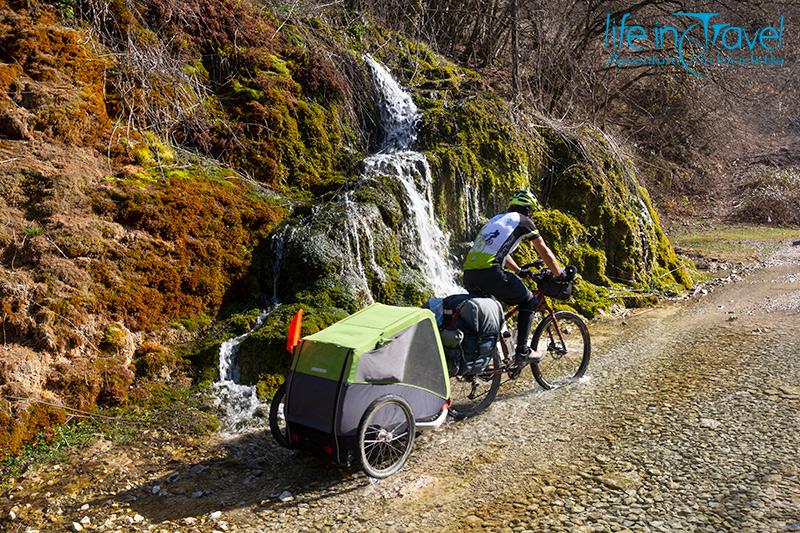 We meet Gino, 60 years old biker waving at us earnestly while Nala runs free. Gino is a Roman retired man who moved to Ferentillo in the heart of Ciociaria: he walks with us towards the Trevi falls even if we have to pass on a bridge that is almost collapsed. After some small talk, he offers us a room a place to stay in his village, but we are forced to refuse because Ferentillo is 1100m high, far from the Way of Saint Benedict... We ride together until Trevi nel Lazio, where he greets us to come back home.
We meet Gino, 60 years old biker waving at us earnestly while Nala runs free. Gino is a Roman retired man who moved to Ferentillo in the heart of Ciociaria: he walks with us towards the Trevi falls even if we have to pass on a bridge that is almost collapsed. After some small talk, he offers us a room a place to stay in his village, but we are forced to refuse because Ferentillo is 1100m high, far from the Way of Saint Benedict... We ride together until Trevi nel Lazio, where he greets us to come back home. 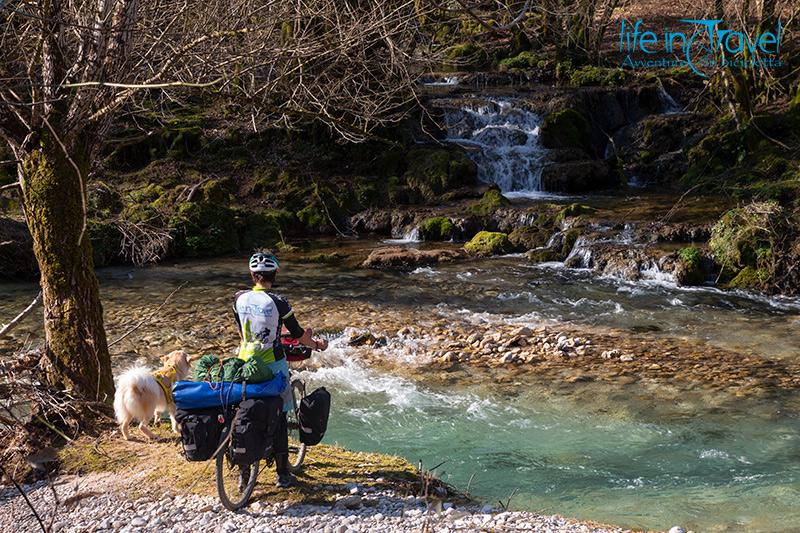 The little village is pleasant and the detour to reach it is worth it: we climb to the castle and with the ticket (2€) we can climb to the top of the tower.
The little village is pleasant and the detour to reach it is worth it: we climb to the castle and with the ticket (2€) we can climb to the top of the tower. The collegiate church and its organ are hardly less so, like the "bomb" of the bar entering the village. From Trevi nel Lazio you climb down, then up towards Altipiani d'Arcinazzo: the garbage, mostly tires, along the way make us really sad, and unfortunately, this is a constant in Lazio. However the rides are fun and we are amazed by the meeting with a UN functionary from Chicago who, after a conference in Rome about climate, is travelling here. He stops with his wife on the side of the road to chat with us and ask for information... he's enthusiastic and he'd like to take his wife in this area to cycle.
The collegiate church and its organ are hardly less so, like the "bomb" of the bar entering the village. From Trevi nel Lazio you climb down, then up towards Altipiani d'Arcinazzo: the garbage, mostly tires, along the way make us really sad, and unfortunately, this is a constant in Lazio. However the rides are fun and we are amazed by the meeting with a UN functionary from Chicago who, after a conference in Rome about climate, is travelling here. He stops with his wife on the side of the road to chat with us and ask for information... he's enthusiastic and he'd like to take his wife in this area to cycle. We continue our Way towards Guarcino and suddenly we notice the devastation caused by last days wind: broken or even uprooted trees at the horizon. After a soft downhill, we reach the village, with the fear of the motorcyclists who mixed up this road and a track, so they accelerate after every turn. Guarcino suddenly appears with the nuns' convent and its skyline. A quick visit gives us some energies that we will need in the next uphill road towards Vico nel Lazio.
We continue our Way towards Guarcino and suddenly we notice the devastation caused by last days wind: broken or even uprooted trees at the horizon. After a soft downhill, we reach the village, with the fear of the motorcyclists who mixed up this road and a track, so they accelerate after every turn. Guarcino suddenly appears with the nuns' convent and its skyline. A quick visit gives us some energies that we will need in the next uphill road towards Vico nel Lazio.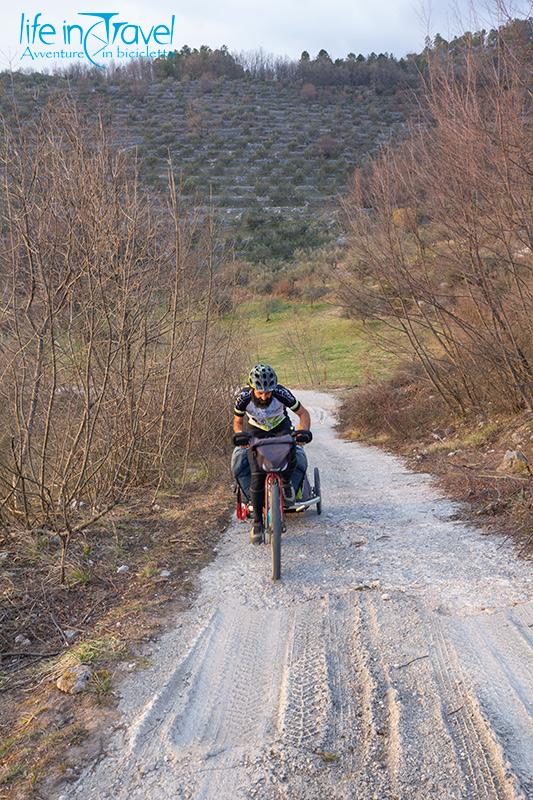 The road becomes gravel, in the middle of olives hills. The warm light of the evening kisses us while the climb increases and the gravel leaves the place to the asphalt. The muscles are tense, the breath is fast and our legs seem to stop working. After the last turn, the road softens and Vico nel Lazio appears with its castle walls. We keep going up, but now on a very calm asphalt, towards Collepardo. A cycle path at the top on the left calls our names and the information indicates a picnic area... the perfect place for the night! The cycle path is a bit of a cathedral in the desert, but the woods and the picnic area are just perfect! The sky goes on fire when the sun goes down at the horizon and we can enjoy our wild camping into nature.
The road becomes gravel, in the middle of olives hills. The warm light of the evening kisses us while the climb increases and the gravel leaves the place to the asphalt. The muscles are tense, the breath is fast and our legs seem to stop working. After the last turn, the road softens and Vico nel Lazio appears with its castle walls. We keep going up, but now on a very calm asphalt, towards Collepardo. A cycle path at the top on the left calls our names and the information indicates a picnic area... the perfect place for the night! The cycle path is a bit of a cathedral in the desert, but the woods and the picnic area are just perfect! The sky goes on fire when the sun goes down at the horizon and we can enjoy our wild camping into nature.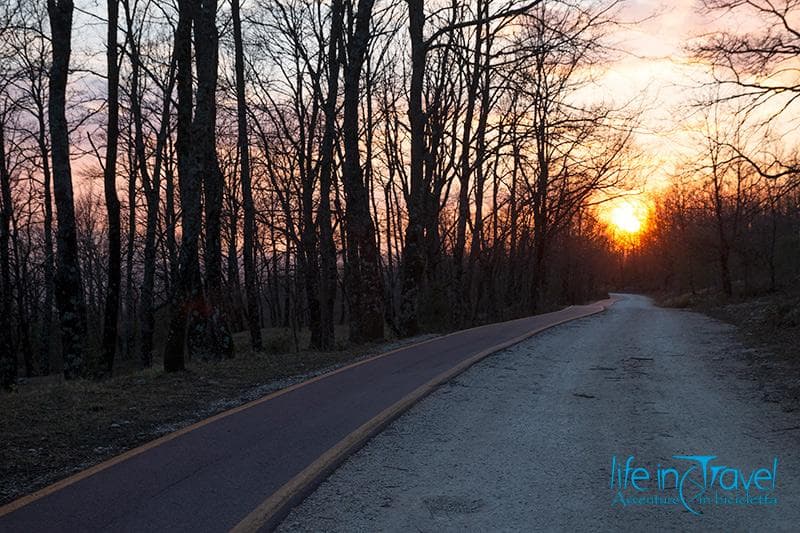
The Charterhouse of Trisulti and the city waterfall
Waking up in the pine grove is sweet, but the temperatures of the morning make us shiver. After the usual operations of prepping, we keep following the cycle path and near camping, we take a fast descent, towards Collepardo, where we will have a super breakfast. The sun warms us but it's mostly the ascent that pumps our blood in our veins and makes our body temperatures rise to natural levels. 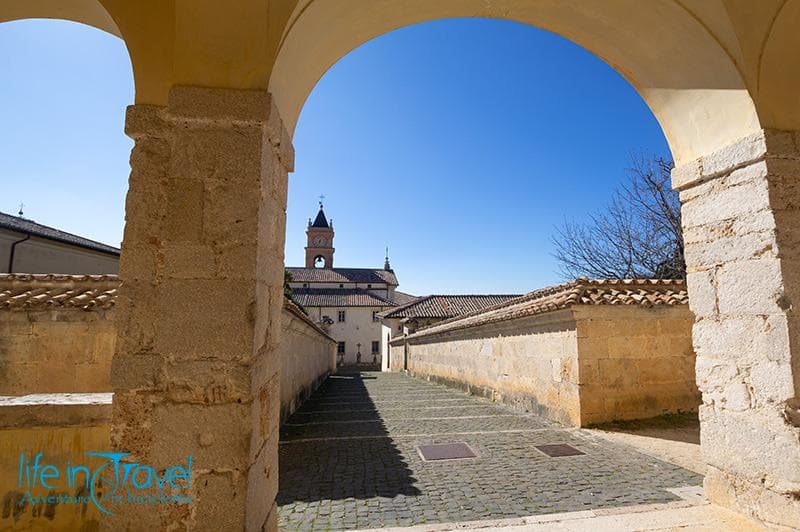 The road towards the Charterhouse of Trisulti does not scare for the ascent but fascinates us for the quiet and the views. In a little we are at the top, full of joy. A bit of relaxing among the horses gives us a sense of inner peace. The road continues uphill until the worship place. Luckily we can take advantage of the first guided tour and ends in the secrets and the rooms of the monastery. The pharmacy from the XVIII century is the most fascinating place.
The road towards the Charterhouse of Trisulti does not scare for the ascent but fascinates us for the quiet and the views. In a little we are at the top, full of joy. A bit of relaxing among the horses gives us a sense of inner peace. The road continues uphill until the worship place. Luckily we can take advantage of the first guided tour and ends in the secrets and the rooms of the monastery. The pharmacy from the XVIII century is the most fascinating place.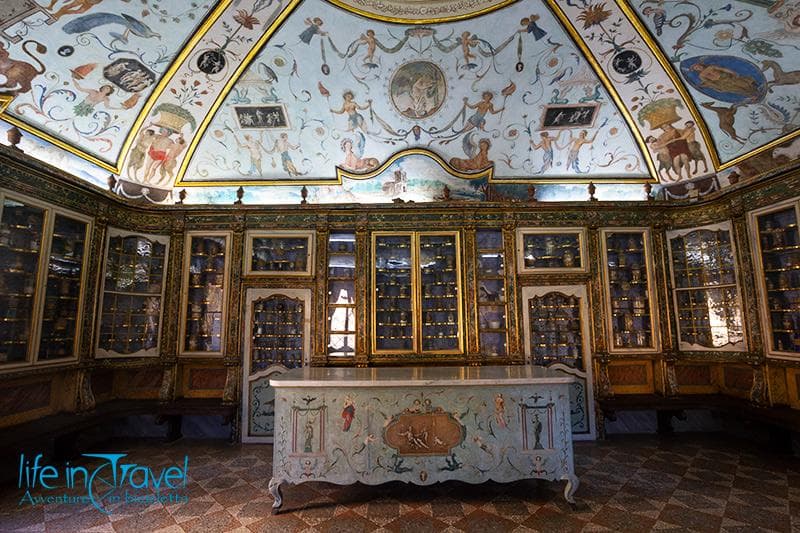 The Cistercians took Carthusian monks place in the management of the place but there is just one monk left, who together with some secular worker now manages the gigantic building. We continue on the road, but unfortunately, we go downhill in a canyon, so we have to climb back on the opposite side. From Civita, we rush downhill until the valley: firstly sweet then abrupt. The Way of Saint Benedict continues on secondary roads and dirt roads among olive trees, with some tough ascents. We reach another worship place: the Casamari Monastery. In order to avoid traffic, we take a road full of ponds caused by the heavy rains of the previous months.
The Cistercians took Carthusian monks place in the management of the place but there is just one monk left, who together with some secular worker now manages the gigantic building. We continue on the road, but unfortunately, we go downhill in a canyon, so we have to climb back on the opposite side. From Civita, we rush downhill until the valley: firstly sweet then abrupt. The Way of Saint Benedict continues on secondary roads and dirt roads among olive trees, with some tough ascents. We reach another worship place: the Casamari Monastery. In order to avoid traffic, we take a road full of ponds caused by the heavy rains of the previous months. 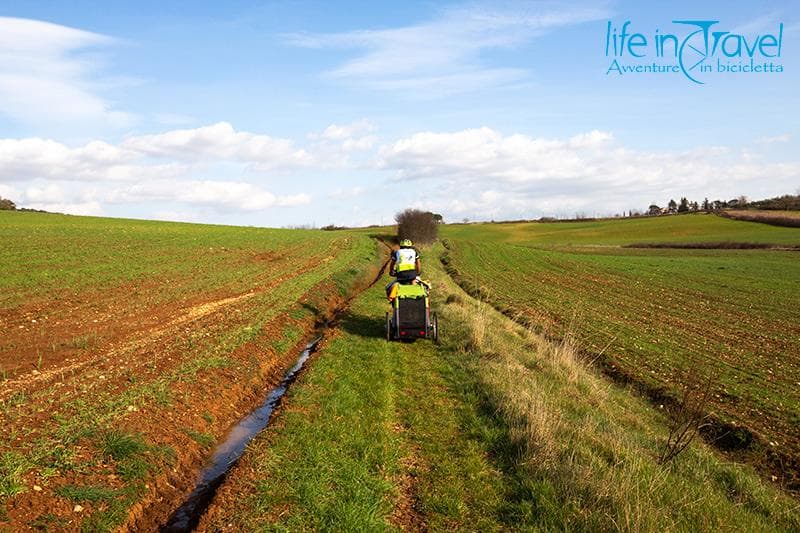 We get stuck in a clayish mud that sticks everything, so it takes some time to get off this natural prison. This leg of the journey is not the best, but luckily we enter Isola del Liri, where its big waterfall and the former paper factory stand out. From this village, uphill, we find a cycle path and an isolated area for camping.
We get stuck in a clayish mud that sticks everything, so it takes some time to get off this natural prison. This leg of the journey is not the best, but luckily we enter Isola del Liri, where its big waterfall and the former paper factory stand out. From this village, uphill, we find a cycle path and an isolated area for camping.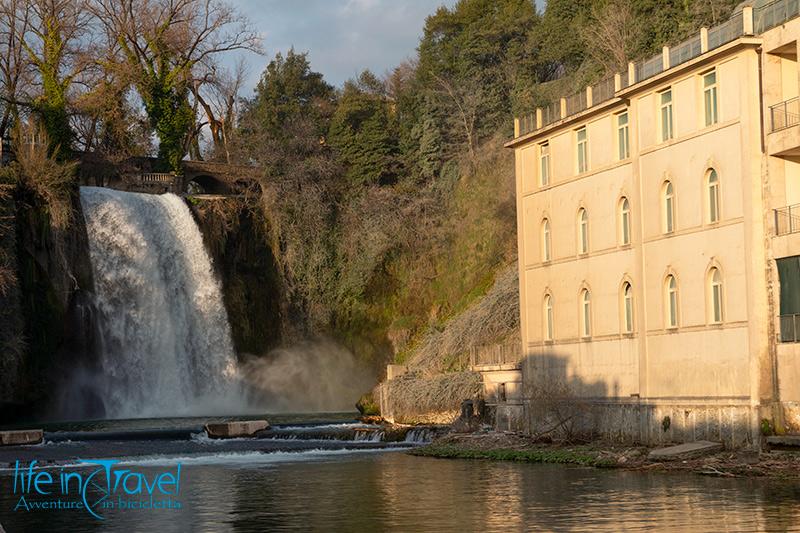
In the city of Tommaso d'Aquino
The large field near the cycle path is perfect for sleeping and start off the day away from traffic... the unexpected is behind the corner, though! The strong wind of the past days uprooted some trees and one of them fell on the cycle path, so we have no choice: either we go back or we grab our bikes with the carrier and move past it. Nala is already over the tree and looks at us like she's calling us: "Guys, hurry up! I don't want to wait all day long!" We got the message: firstly we unplug the carrier to take it separately, then we lift our bikes, but with the third try Leo twists his ankle. Leo is on the ground with his bike on him: he stands, but he will be aching all day. 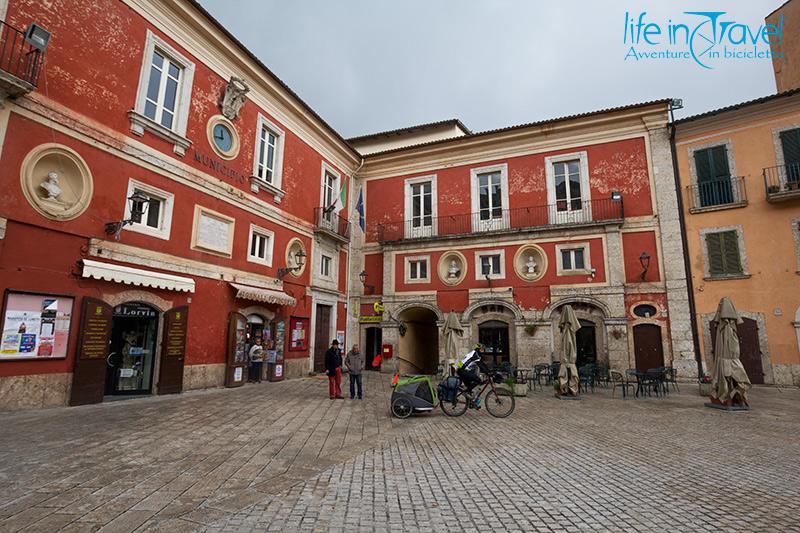 Leaving behind Isola del Liri we ride towards Arpino, city of Cicero and Caio Mario, seven times Consul. Streets in Arpino are full of particular details fun to discover, but even more interesting is Civitavecchia Old Acropolis, at the top of the urban settlement.
Leaving behind Isola del Liri we ride towards Arpino, city of Cicero and Caio Mario, seven times Consul. Streets in Arpino are full of particular details fun to discover, but even more interesting is Civitavecchia Old Acropolis, at the top of the urban settlement. With the tower of Cicerone, the only pointed arch in the walls still present in the Mediterranean area and its polygonal masonry, this village is like living in another time. We leave behind the old city pushing the bikes on a steep dirt road along 300m. The asphalt crosses some old houses, a flock of sheep and some up and downhills, testing our training.
With the tower of Cicerone, the only pointed arch in the walls still present in the Mediterranean area and its polygonal masonry, this village is like living in another time. We leave behind the old city pushing the bikes on a steep dirt road along 300m. The asphalt crosses some old houses, a flock of sheep and some up and downhills, testing our training. After Madonna delle fosse we reach the river Melfa that drew a suggestive canyon. Here too we cannot avoid the garbage everywhere... - welcome to hell - we will read on the door of a shop, with a picture of this canyon.
After Madonna delle fosse we reach the river Melfa that drew a suggestive canyon. Here too we cannot avoid the garbage everywhere... - welcome to hell - we will read on the door of a shop, with a picture of this canyon.
Roccasecca, the city of San Tommaso d'Aquino, appears after the canyon among the thick vegetation. Nala, on her carrier during the descent, can now come out of it and walk with us, looking for something interesting. Our ride raises curiosity: in Roccasecca too we cause some big smiles.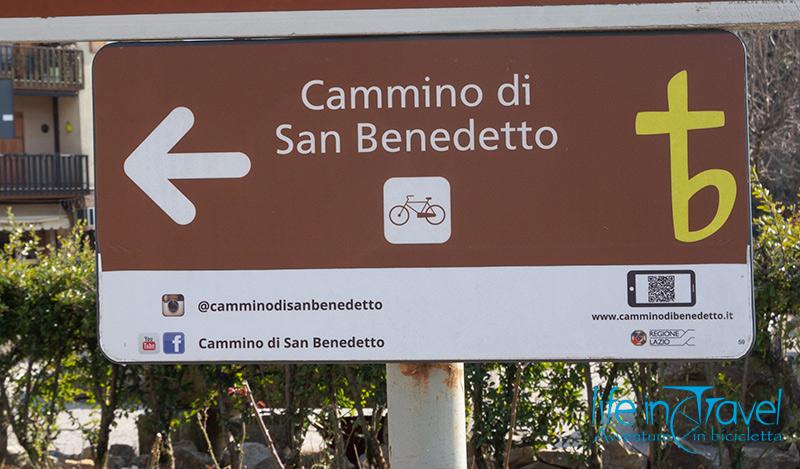 An old man, sitting in the coffee shop where we decide to have a quick break, wants to offer us a beer: we drink toasting for him. The evening is coming fast, but we absolutely want to visit the castle that dominates the village, so we cycle uphill to reach it. This castle is a real balcony over the valley and, during this season, it is the right place to camp. Tonight we have a castle for us: we're so lucky and grateful.
An old man, sitting in the coffee shop where we decide to have a quick break, wants to offer us a beer: we drink toasting for him. The evening is coming fast, but we absolutely want to visit the castle that dominates the village, so we cycle uphill to reach it. This castle is a real balcony over the valley and, during this season, it is the right place to camp. Tonight we have a castle for us: we're so lucky and grateful.
The last stage: Montecassino
Our last day on the Way of Saint Benedict brought us from Roccasecca to Castrocielo first and Piedimonte San Germano then. Without any particularly difficult moments, under a brilliant springy sun, we reach the suburbs of Cassino, where the climb towards the Abbey is sweet: 445 meters and 8,5 km. The Abbey is 516m above sea level, a pleasant road uphill, easy to face during spring days. You can see the plains or the snowy mountains of Abruzzo in a colourful show. Benedict from Norcia, in 549, founded his first Monastery right on this mountain that during some centuries experienced earthquakes, bombings, and reconstructions. In this symbolic place, centuries after the coming of Benedict from Norcia, the first document in vernacular Italian was written. Almost 1500 years after the death of the Saint, this Abbey is one of the most beautiful places along a cycle and walking Way, the Way of Saint Benedict.
You can see the plains or the snowy mountains of Abruzzo in a colourful show. Benedict from Norcia, in 549, founded his first Monastery right on this mountain that during some centuries experienced earthquakes, bombings, and reconstructions. In this symbolic place, centuries after the coming of Benedict from Norcia, the first document in vernacular Italian was written. Almost 1500 years after the death of the Saint, this Abbey is one of the most beautiful places along a cycle and walking Way, the Way of Saint Benedict.
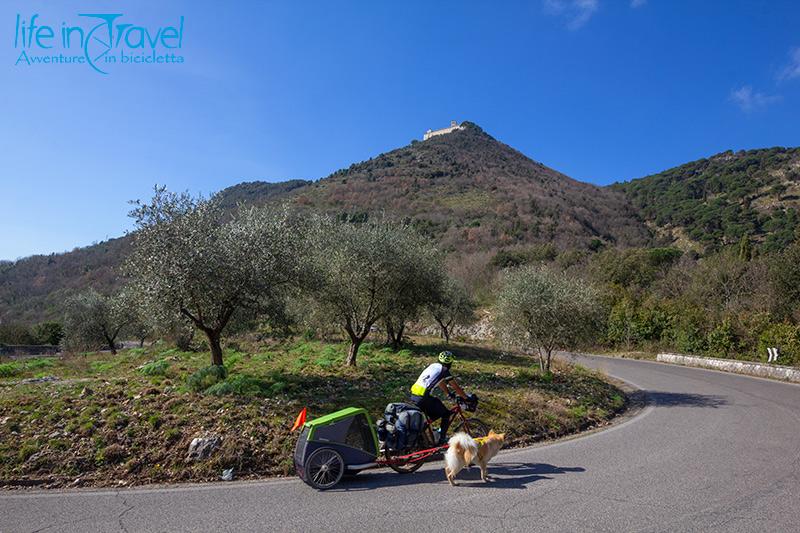
If you need further information to cycle along the Way of Saint Benedict's, you can purchase the guide by Frignani edited by Terre di Mezzo.
- The city of Saint Benedict, the beautiful Norcia in the Sibillini National Park
- The small and beautiful Orvinio and Castel di Tora
- Subiaco and Saint Benedict monasteries
- The quiet Trevi nel Lazio and the surrounding areas
- The Aniene valley from Subiaco... stunning to ride through it
- The village waterfall in Isola di Liri
- The fortress in Roccasecca, a magic place to discover
- Montecassino and the famous abbey
- How can I reach Norcia? You can reach Norcia by train + coach until Spoleto (line Roma - Ancona) or by bike on the Spoleto - Norcia old railway) and then using the Bus Transport to Norcia.
- How can I get back from Montecassino? The train station of Cassino is on the line Roma - Cassino - Napoli, so it is comfortable to get back by train.
- Is this itinerary signposted? This itinerary is very well signposted, with brown signs along it.
- Are there water sources or fountains? You can find many water sources on this itinerary, especially in the villages.
- How are the roads on the Saint Benedict Way? It's a mix of good paved roads and gravel ones, in certain parts pretty demanding. With good training you can ride on this itinerary also fully loaded.
- Connected itineraries:in Norcia you can connect backward to the old railway Spoleto - Norcia, while from Rieti you can connect to the Francis Way, dedicated to the Saint..
Where to sleep on the Saint Benedict Way?
- The itinerary of Saint Benedict Way by bike is a multi-days journey. On the itinerary you can sleep in B&B, hotels and other hosting facilities, depending on your rhytm. If you prefer a whole apartment, check on AirBnB.
Where and what to eat on the Saint Benedict Way?
- This area in Umbria is very well known for its great cold cuts (sold in the typical norcinerie!), for meat dishes like braciole di castrato or different types of pasta like stringozzi from Spoleto. In Norcia and Castelluccio you must try lentils, spelt and cold cuts. Many times you'll find black truffles in sauces or dishes.
- If you stay in Norcia, you cannot miss a stop in a typical norcineria or osteria for some specialties. We suggest: the Ristorante Granaro del Monte, the Osteria Sienti'n può, the Ristorante Vespasia and the Taverna del Boscaiolo.
- In Lazio you will try typical cooking like spaghetti all'amatriciana, fregnacce, abbacchio, the cordelle sabine... every village has its own traditions, so it will be a real discovery path in Italian cooking story!
- Umbria Tourism: Umbria's official website
- Visit Lazio: Lazio's official website
- Sabina Dop: info and the area of Sabina
- Saint Benedict Way: the official website of the Way of Saint Benedict from Norcia to Montecassino
Log in with ( Sign Up ? )
or post as a guest
Be the first to comment.

Francesco G
ITA - Ho 33 anni e sono piemontese, anche se da qualche anno vivo e lavoro in Lombardia. Dopo un inizio da totale inesperto in questo campo, mi sono avvicinato al mondo dei cicloviaggi e della bicicletta sempre più. Oggi posso definirmi "cicloviaggiatore", e assieme all'altra mia passione - il videomaking - non mi fermerei mai! Cyclo ergo sum, pedalo quindi sono, per cercare di capire perché andare in bici sia così bello, terapeutico, ricco... E ogni volta che provo a capirlo, non ce la faccio, e sono costretto a ripartire sui pedali!
ENG - I'm from Piedmont and I'm 33 years old, I have been living and working in Lombardy for a few years. After a start without any competence in this field, I then approached the bicycle world more and more. Today I can call myself a bicycle traveller and videomaker who would never ever stop. Cyclo ergo sum, I cycle therefore I am. I ride my bike trying to understand why it is so beautiful, rich, therapeutic. And every time I try, I do not understand it. So I must leave again...
Latest from Francesco G
- Farewell Iohan Gueorguiev, you will always inspire us!
- The Oglio Greenway: cycling adventure from Tonale to Po
- Naturehike Cloud Up 2: my review of this bikepacking tent
- Bikepacking or Bike Touring? This is the question
- Best gravel handlebars and how to choose them
- Roswheel bags: Roswheel Tour Pannier Large review


